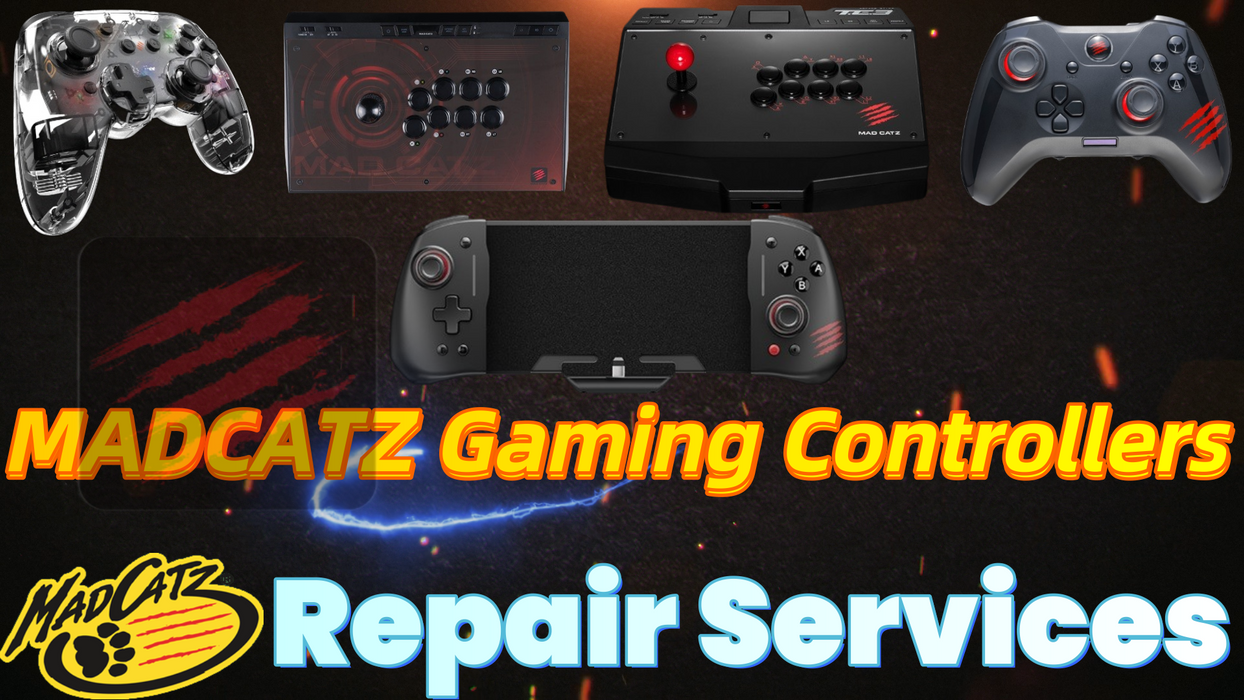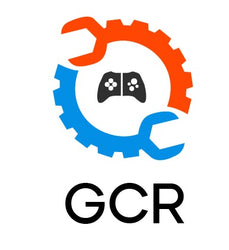

Mad Catz Gaming Controller Repairs
Get a FREE Quote
Madcatz gaming controllers are known for their affordability and innovative designs, but they can suffer from a variety of issues over time due to heavy use or manufacturing defects. Here are the common problems associated with repairs for Mad catz gaming controllers, along with potential solutions:
1. Analog Stick Drift (Joystick Drift)
- Problem: The analog sticks register movement even when not being touched.
- Cause: Wear and tear on the internal sensors (potentiometers) or debris build-up.
- Solution: Clean the analog sticks with compressed air or contact cleaner. If the drift persists, replace the analog stick modules.
2. Unresponsive Buttons
- Problem: Face buttons (A, B, X, Y) or shoulder buttons (L1, R1, etc.) don’t respond when pressed.
- Cause: Worn-out button contact points or dirt underneath the buttons.
- Solution: Open the controller and clean the button contacts, or replace the membrane underneath the buttons if necessary.
3. Sticky or Stuck Buttons
- Problem: Buttons are difficult to press or get stuck after being pressed.
- Cause: Dirt, grime, or spilled liquids have accumulated inside the button housing.
- Solution: Disassemble the controller to clean the buttons and their surrounding area with isopropyl alcohol.
4. Trigger Malfunction
- Problem: Triggers (L2, R2) do not function correctly or are unresponsive.
- Cause: Worn-out springs, damaged internal components, or sensor failure.
- Solution: Inspect the trigger mechanism for damage, clean it, or replace the trigger assembly or sensor.
5. Worn-out Thumbstick Grips
- Problem: The rubber grips on the thumbsticks wear down or tear.
- Cause: Heavy use over time, poor material quality.
- Solution: Replace the thumbstick grips or replace the entire thumbstick assembly.
6. Connection Issues (Wired and Wireless)
- Problem: The controller does not connect to the console or PC or loses connection mid-game.
- Cause: For wired controllers, this could be due to damaged USB cables or ports. For wireless controllers, it could be a problem with the Bluetooth or wireless module.
- Solution: Check for broken or frayed cables and replace them if needed. For wireless controllers, reset the controller or update its firmware. Replace the wireless module if necessary.
7. Battery Charging Problems (Wireless Models)
- Problem: The wireless controller doesn’t charge or holds a charge for a very short time.
- Cause: Damaged charging port, faulty battery, or broken charging cable.
- Solution: Replace the charging port or battery, or try a new charging cable.
8. Vibration Motor Issues
- Problem: The rumble feature stops working or is inconsistent.
- Cause: Faulty or disconnected vibration motors, or a short circuit in the wiring.
- Solution: Open the controller and inspect the motors. Replace any defective motors or reconnect loose wires.
9. D-Pad Problems
- Problem: The D-pad doesn’t register inputs correctly or feels mushy.
- Cause: Worn-out contact points or debris under the D-pad.
- Solution: Clean the D-pad contacts or replace the membrane to improve responsiveness.
10. Audio Jack Issues
- Problem: The controller’s headphone jack doesn’t work or only outputs sound in one ear.
- Cause: Dust or debris in the audio jack, or internal damage to the jack itself.
- Solution: Clean the audio jack with compressed air or replace the jack if it’s damaged.
11. Loose Internal Wiring
- Problem: Buttons or triggers only work intermittently, or the controller shuts down unexpectedly.
- Cause: Loose or damaged internal wiring, possibly from being dropped.
- Solution: Open the controller, inspect the wiring, and re-solder or replace any loose connections.
12. Overheating Issues
- Problem: The controller becomes hot during use, especially during long gaming sessions.
- Cause: Overheating of internal components due to poor heat dissipation.
- Solution: Allow the controller to cool down and check for signs of damage to internal components. In severe cases, parts may need replacement.
13. Firmware or Software Glitches
- Problem: Erratic controller behavior, such as input lag, freezing, or failure to connect properly.
- Cause: Outdated firmware, software bugs, or driver conflicts.
- Solution: Update the controller’s firmware, reinstall drivers, and check for software conflicts.
14. Shoulder Button Failure
- Problem: Shoulder buttons (L1, R1) stop working or become unresponsive.
- Cause: Worn-out button contacts or internal damage.
- Solution: Clean or replace the contact membranes, or replace the shoulder buttons entirely.
15. Non-Functioning LEDs
- Problem: LED lights on the controller (for connection or battery status) don’t function properly.
- Cause: Burned-out LEDs or faulty connections.
- Solution: Replace the non-functioning LEDs or inspect and fix any wiring issues.
16. Lag or Latency Issues (Wireless Models)
- Problem: Noticeable delay between controller input and action on the screen.
- Cause: Poor wireless signal, outdated firmware, or interference from other wireless devices.
- Solution: Move closer to the console or PC, update the firmware, or eliminate nearby sources of interference.
17. Cracked or Broken Casing
- Problem: The outer shell of the controller is cracked or broken, exposing internal components.
- Cause: Physical impact or heavy use.
- Solution: Replace the damaged outer shell or casing.
Mad catz controllers are popular due to their affordable pricing and wide availability, but many users experience these issues after extended use. Timely maintenance, cleaning, and part replacements can help keep these controllers functioning properly.
If unable to resolve the issue with your Mad catz Gaming Controller, book now and let us get your controller up and running in no time
Product Reviews
Add customer reviews and testimonials to showcase your store's happy customers.
Author's name
Add customer reviews and testimonials to showcase your store's happy customers.
Author's name
Add customer reviews and testimonials to showcase your store's happy customers.
Author's name
